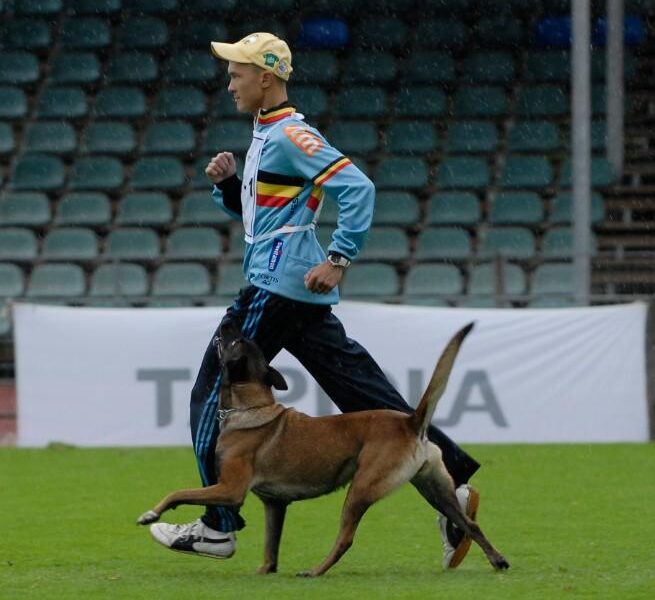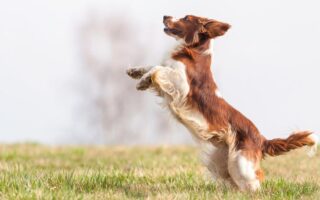Unleashing Potential: The Art and Science of Schutzhund Training
In a world where the bond between humans and dogs transcends mere companionship, Schutzhund training emerges as a captivating blend of sport, discipline, and teamwork. Originating in Germany during the early 20th century, this multifaceted canine sport not only showcases the exceptional abilities of dogs but also emphasizes their loyalty, intelligence, and resilience. As participants delve into the rigorous training regimen that emphasizes obedience, tracking, and protection work, they discover a unique opportunity to forge a deeper connection with their canine companions. Beyond the thrill of competition, Schutzhund serves as a testament to the incredible potential that lies within every dog—waiting to be unleashed through guidance, trust, and perseverance. Join us as we explore the intricacies of Schutzhund training, offering insights into its history, methodology, and the profound relationship it fosters between man and dog.
Table of Contents
- Understanding the Roots of Schutzhund Training
- Essential Skills Developed Through Schutzhund
- Safety First: Best Practices for Training Dogs
- Choosing the Right Breed for Schutzhund Success
- Q&A
- The Conclusion
Understanding the Roots of Schutzhund Training
Schutzhund, a German word meaning “protection dog,” has its origins rooted in the need for a comprehensive working test for dogs. Initially developed in the early 20th century, this rigorous training system was designed to evaluate and breed strong, versatile canines, particularly the German Shepherd. The roots of Schutzhund lie in three main disciplines: tracking, obedience, and protection. Each component not only fosters skill but also strengthens the bond between dog and handler, ensuring the dog’s capability in various situations such as search and rescue, police work, and companionship.
The training methodology emphasizes a strong foundation in obedience and communication, prioritizing trust and teamwork. In a typical training program, dogs learn to perform complex tasks under varying levels of distraction. Key elements involved in training include:
- Tracking: Teaching dogs to follow scents over great distances.
- Obedience: Establishing commands that ensure dogs remain attentive and compliant.
- Protection Techniques: Training dogs to protect their handler while adhering to safety protocols.
This multi-faceted approach not only enhances the dog’s physical and mental capabilities but also prepares them for real-world applications, allowing for a deeper understanding of the relationship between handler and hound.
Essential Skills Developed Through Schutzhund
Participating in Schutzhund training programs fosters a variety of essential skills that extend beyond the bond between a dog and its handler. First and foremost, communication becomes paramount. Handlers must learn to articulate commands clearly and succinctly while interpreting their dog’s body language and responses effectively. This bidirectional communication enhances mutual understanding, creating a stronger partnership. Alongside communication, the development of patience is equally crucial. Mastering the various elements of Schutzhund, from tracking and obedience to protection work, often requires time and repetition, allowing handlers to cultivate perseverance and resilience in the face of challenges.
Moreover, Schutzhund training significantly enhances focus—both for the dog and the handler. Dogs trained in this discipline learn to maintain concentration despite distractions, honing their ability to work effectively in diverse environments. Handlers also improve their focus as they must remain attentive to their dog’s cues and reactions. This program instills a profound sense of discipline as both parties learn the importance of practice, commitment, and consistency. Additionally, the teamwork cultivated in Schutzhund encourages a deep sense of trust, fostering a relationship that thrives on reliability and support, essential qualities for any successful partnership both in and out of the training arena.
Safety First: Best Practices for Training Dogs
When it comes to schutzhund training, ensuring safety for both the dog and trainer is paramount. Start by creating a controlled environment where distractions are minimized. Utilize a secure training area that is fenced in or enclosed, allowing the dog to focus solely on the exercises without any external interruptions. This not only helps in maintaining the attention of the dog but also ensures that they are less likely to react unpredictably to outside stimuli. It’s crucial to always have the right equipment, including a well-fitted collar, leash, and, if necessary, a muzzle for safety during advanced training. Additionally, ensure that all training tools such as bite sleeves and protection suits are in excellent condition to prevent accidents during practice.
Another key component of safe training practices is understanding your dog’s limits. Each dog has its own set of capabilities and thresholds, and pushing them beyond their capacity can lead to injuries. Regularly assess your dog’s physical condition and mood before training sessions. Create a ritual that includes warm-up exercises to prepare them for the activities ahead. Additionally, always incorporate breaks into your sessions to help the dog recover and avoid fatigue. The following table outlines essential warm-up exercises that can serve to enhance both safety and performance:
| Exercise | Duration | Purpose |
|---|---|---|
| Gentle Walking | 5 minutes | Loosen muscles and joints |
| Controlled Fetch | 5 minutes | Builds focus and physical readiness |
| Stretching | 5 minutes | Prevent injuries and increase flexibility |
| Basic Commands | 5 minutes | Enhance communication and engagement |
Choosing the Right Breed for Schutzhund Success
Selecting the appropriate breed for Schutzhund training is fundamental for achieving success in this demanding canine sport. While many breeds are capable of excelling in Schutzhund, some are particularly renowned for their innate traits that align well with the sport’s requirements. Consider breeds that exhibit high intelligence, strong work ethic, and robust physicality. Breeds such as the German Shepherd, Belgian Malinois, and Rottweiler have consistently proven their worth in Schutzhund competitions, owing to their loyalty, trainability, and protective instincts. Here are some desirable traits to look for in a breed:
- Energy Level: A high energy level ensures the dog can engage in vigorous training sessions.
- Temperament: A stable temperament is crucial, as it affects how well the dog interacts with trainers and other dogs.
- Drive: A strong prey drive can enhance a dog’s performance in tracking and obedience tasks.
- Socialization: Breeds that are naturally friendly with people and other dogs tend to adapt better to training environments.
Additionally, understanding the various capabilities and limitations of specific breeds can significantly impact your Schutzhund journey. For example, while German Shepherds excel in both protection and tracking, Belgian Malinois might offer more agility. It’s essential to match your goals with the characteristics of the breed. Below is a table showcasing some of the top breeds for Schutzhund and their key strengths:
| Breed | Strengths |
|---|---|
| German Shepherd | Versatile, intelligent, strong protector |
| Belgian Malinois | Agile, high energy, exceptional drive |
| Rottweiler | Powerful, confident, loyal |
| Doberman Pinscher | Alert, versatile, strong guardian |
Q&A
Q&A: Understanding Schutzhund
Q: What is Schutzhund?
A: Schutzhund, which translates to “protection dog” in German, is a modern dog sport that assesses a dog’s capabilities in tracking, obedience, and protection. Originally developed in Germany in the early 20th century to evaluate working dogs, it has gained popularity as a sport and training discipline worldwide.
Q: What are the main components of Schutzhund?
A: Schutzhund comprises three key components: tracking, obedience, and protection.
- Tracking: Dogs are trained to follow a scent trail left by a person, demonstrating their ability to locate and indicate the presence of an object or person of interest.
- Obedience: This segment tests the dog’s responsiveness to commands, showcasing their training, discipline, and bond with the handler.
- Protection: This aspect evaluates a dog’s instinct to protect its handler, featuring controlled scenarios where the dog must apprehend an “intruder” while demonstrating control and composure.
Q: Can any breed participate in Schutzhund?
A: While certain breeds are more commonly associated with the sport—such as German Shepherds, Rottweilers, and Doberman Pinschers—Schutzhund is open to various breeds and mixed-breed dogs. The emphasis lies on a dog’s temperament, drive, and willingness to learn, rather than its breed alone.
Q: What skills does a dog gain through Schutzhund training?
A: Training for Schutzhund builds a wide array of skills in dogs, including enhanced obedience, strong tracking abilities, and reliable protection instincts. Additionally, it fosters a deep bond between the dog and handler, increases confidence in the dog, and improves socialization skills through exposure to different environments and challenges.
Q: Is Schutzhund training suitable for all dog owners?
A: Schutzhund training can be rewarding but requires a dedicated commitment from dog owners. It’s essential for handlers to have a basic understanding of dog training principles and to approach training with patience and clarity. While it can be enjoyable for many, those seeking a casual experience may find that the sport’s demands may not align with their goals.
Q: How does Schutzhund differ from other dog sports?
A: Unlike agility or flyball, which emphasize speed and course navigation, Schutzhund focuses on a dog’s working ability, stability, and reliability in various scenarios. It blends mental and physical challenges, pushing both the dog and handler to develop a profound understanding of teamwork, control, and problem-solving.
Q: What are the benefits of participating in Schutzhund training?
A: Engaging in Schutzhund training offers numerous benefits, such as improved obedience, heightened mental stimulation for the dog, and enhanced physical fitness. For handlers, it encourages the development of training skills, strengthens the human-dog bond, and fosters a sense of community among fellow enthusiasts.
Q: Is Schutzhund recognized internationally?
A: Yes, Schutzhund is a worldwide recognized sport, governed by various organizations, such as the Fédération Cynologique Internationale (FCI) and the American Schutzhund Association (ASA). Competitions are held globally, showcasing the skills of dogs and handlers alike and promoting the sport’s principles internationally.
With its blend of precision, discipline, and teamwork, Schutzhund remains a captivating arena for both dogs and their handlers, celebrating the unique capabilities and bonds formed between humans and their canine companions.
The Conclusion
schutzhund represents much more than just a dog sport; it embodies a harmonious blend of training, discipline, and a deep bond between handler and canine. As we’ve explored, this rigorous and rewarding discipline not only highlights the physical and mental capabilities of dogs but also underscores the commitment and dedication of their trainers. Whether you are a seasoned competitor or simply an admirer of this unique pursuit, schutzhund inspires us to appreciate the resilience and intelligence of our four-legged companions. As you continue on your own journey with dogs, let the spirit of schutzhund remind you of the incredible potential that lies within every partnership, driven by trust, respect, and shared goals.



